初中英语课例研究报告样本
课例研究报告范文初中英语
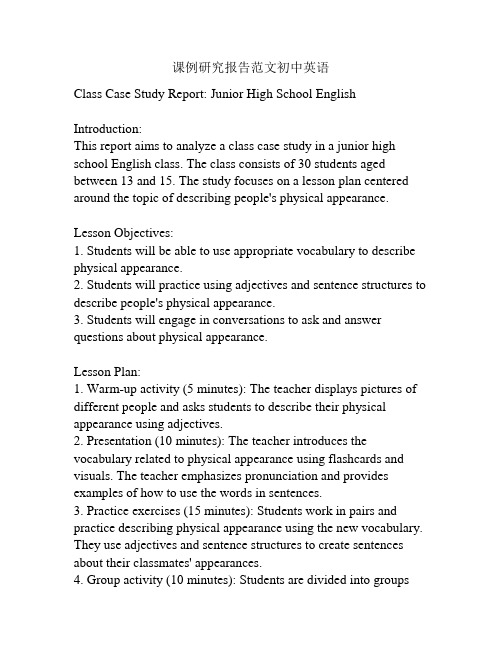
课例研究报告范文初中英语Class Case Study Report: Junior High School English Introduction:This report aims to analyze a class case study in a junior high school English class. The class consists of 30 students aged between 13 and 15. The study focuses on a lesson plan centered around the topic of describing people's physical appearance. Lesson Objectives:1. Students will be able to use appropriate vocabulary to describe physical appearance.2. Students will practice using adjectives and sentence structures to describe people's physical appearance.3. Students will engage in conversations to ask and answer questions about physical appearance.Lesson Plan:1. Warm-up activity (5 minutes): The teacher displays pictures of different people and asks students to describe their physical appearance using adjectives.2. Presentation (10 minutes): The teacher introduces the vocabulary related to physical appearance using flashcards and visuals. The teacher emphasizes pronunciation and provides examples of how to use the words in sentences.3. Practice exercises (15 minutes): Students work in pairs and practice describing physical appearance using the new vocabulary. They use adjectives and sentence structures to create sentences about their classmates' appearances.4. Group activity (10 minutes): Students are divided into groupsand given different pictures of people. They discuss the physical appearance of the people in the pictures and present their findings to the rest of the class.5. Role play (15 minutes): Students pair up and act as a reporter and a famous person. The reporter asks questions about the famous person's physical appearance, and the famous person answers using adjectives and sentence structures learned in the lesson.6. Conclusion (5 minutes): The teacher summarizes the key points of the lesson and asks students to reflect on what they have learned. Classroom Observation:During the lesson, the students were engaged and actively participated in the activities. They eagerly used the new vocabulary to describe each other's physical appearance. The group activity and role play stimulated conversations and interactions among the students. The teacher provided clear explanations and examples, which helped the students grasp the concepts easily.Summary and Conclusion:This class case study demonstrated an effective lesson plan for teaching physical appearance vocabulary in a junior high school English class. The activities provided opportunities for students to practice using the vocabulary and encouraged them to communicate with each other in English. The teacher's clear explanations and well-designed activities contributed to a successful and engaging learning environment. Overall, the lesson plan effectively achieved the intended objectives and enhanced the students' English language skills.。
初三作文之初中英语课例研究报告

初三作文之初中英语课例研究报告————————————————————————————————作者: ————————————————————————————————日期:初中英语课例研究报告【篇一:初中英语课例研究报告(正稿)】英语课例研究报告研究主题:初二英语听说课教学课目:module7feelings andimpressions unit1教学年级:初二年级执教教师:吴鹏程研究教师:朱妙容庞英邓国云鄔乃禄潘艺娜廖理会蓝华萍党莉指导老师: 吴凌羽研究过程:一、原始课例回顾我们一年多的教学实践,又认真观摩了多节新教材的研讨课,我们发现虽然使用了新教材,但在speaking教学过程中仍受传统模式的干扰。
导致学生在“说”课堂上动口,动脑意识不强。
那么教师如何设计“speaking”的教学,使得课堂气氛活跃,让学生真正成为教学主体,在教学过程中确确实实地“动”起来就成为我们研究的主要内容。
活动内容: 通过本模块的学习,学生可以学会表达自己的感觉和印象。
话题背景:本模块以感觉与印象为话题, 内容主要是谈论对食物等的感觉、评论以及对人的印象等。
了解表感觉和知觉的系动词的用法;了解英国女孩sally的情感态度和喜好,很符合学生的兴趣,语言实践活动比较好开展。
学生可以围绕这一话题进行大量的听、说、读、写方面的语言实践活动。
阅读的重点在于理解,在此基础上学会一些描述人长相和性格的表达方式,包括句式和一些形容词。
教学目的:通过谈论感觉与印象训练学生的听、说、读、写能力,掌握使用表感觉和知觉系动词和系表结构,养成正确表达感觉与印象的能力。
教学重点:1.能正确使用表感觉和知觉的系动词:sound,sme ll,look, taste, feel; 掌握句子的系表结构:link verb+adj.2. 能够对食物的味道、人的印象等进行评论。
教学难点:1、掌握一些句型的用法2、如何提高学生的口语能力教学方法:分组讨论,使学生自由交谈,然后分角色表演。
初中英语研究性学习报告范文精选5篇-口语研究性报告范文
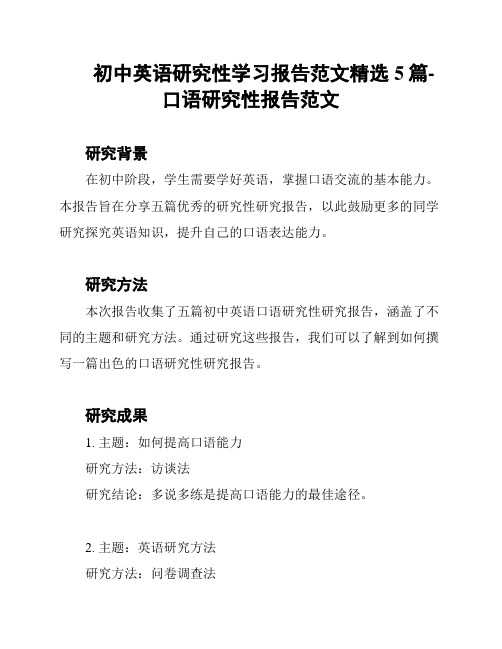
初中英语研究性学习报告范文精选5篇-
口语研究性报告范文
研究背景
在初中阶段,学生需要学好英语,掌握口语交流的基本能力。
本报告旨在分享五篇优秀的研究性研究报告,以此鼓励更多的同学研究探究英语知识,提升自己的口语表达能力。
研究方法
本次报告收集了五篇初中英语口语研究性研究报告,涵盖了不同的主题和研究方法。
通过研究这些报告,我们可以了解到如何撰写一篇出色的口语研究性研究报告。
研究成果
1. 主题:如何提高口语能力
研究方法:访谈法
研究结论:多说多练是提高口语能力的最佳途径。
2. 主题:英语研究方法
研究方法:问卷调查法
研究结论:阅读和听力是研究英语的重要方法。
3. 主题:英语口语比赛经验分享
研究方法:实证研究法
研究结论:练和准备是赢得口语比赛的关键。
4. 主题:短语和惯用语的使用
研究方法:实地考察法
研究结论:熟练掌握短语和惯用语能有效提升口语表达水平。
5. 主题:中国文化在英语研究中的运用
研究方法:文献研究法
研究结论:借鉴中国文化在英语研究中能使个人表达更丰富、得体。
结论
通过以上五篇研究性学习报告的分享,我们可以看到不同主题和方法带来的不同结论。
学习不止是书本上的知识,同时也需要我们自己的实践和探究。
希望通过这次报告能够激发更多同学热爱学习英语,勇于探索,不断提升自己的口语交流能力。
初中英语上课教研报告(3篇)
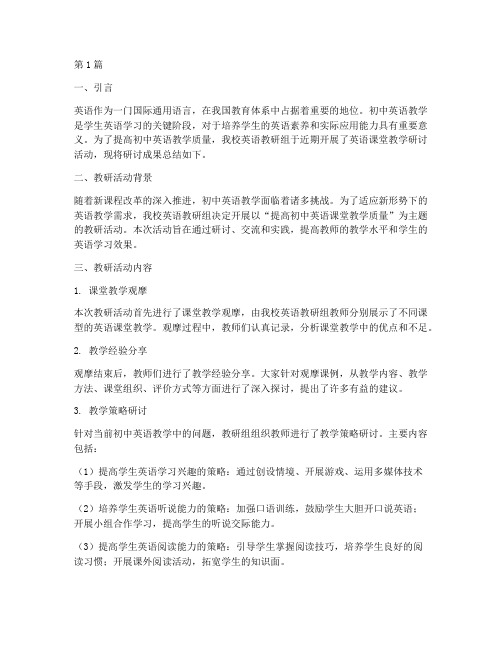
第1篇一、引言英语作为一门国际通用语言,在我国教育体系中占据着重要的地位。
初中英语教学是学生英语学习的关键阶段,对于培养学生的英语素养和实际应用能力具有重要意义。
为了提高初中英语教学质量,我校英语教研组于近期开展了英语课堂教学研讨活动,现将研讨成果总结如下。
二、教研活动背景随着新课程改革的深入推进,初中英语教学面临着诸多挑战。
为了适应新形势下的英语教学需求,我校英语教研组决定开展以“提高初中英语课堂教学质量”为主题的教研活动。
本次活动旨在通过研讨、交流和实践,提高教师的教学水平和学生的英语学习效果。
三、教研活动内容1. 课堂教学观摩本次教研活动首先进行了课堂教学观摩,由我校英语教研组教师分别展示了不同课型的英语课堂教学。
观摩过程中,教师们认真记录,分析课堂教学中的优点和不足。
2. 教学经验分享观摩结束后,教师们进行了教学经验分享。
大家针对观摩课例,从教学内容、教学方法、课堂组织、评价方式等方面进行了深入探讨,提出了许多有益的建议。
3. 教学策略研讨针对当前初中英语教学中的问题,教研组组织教师进行了教学策略研讨。
主要内容包括:(1)提高学生英语学习兴趣的策略:通过创设情境、开展游戏、运用多媒体技术等手段,激发学生的学习兴趣。
(2)培养学生英语听说能力的策略:加强口语训练,鼓励学生大胆开口说英语;开展小组合作学习,提高学生的听说交际能力。
(3)提高学生英语阅读能力的策略:引导学生掌握阅读技巧,培养学生良好的阅读习惯;开展课外阅读活动,拓宽学生的知识面。
(4)提高学生英语写作能力的策略:注重写作技巧的培养,引导学生进行有效的写作练习;开展写作评价活动,提高学生的写作水平。
4. 教学反思与改进在教研活动中,教师们对自己的教学进行了反思,总结了以下改进措施:(1)加强教学研究,提高自身业务水平。
(2)关注学生个体差异,实施分层教学。
(3)优化教学方法,提高课堂教学效率。
(4)加强家校沟通,共同促进学生英语学习。
优秀的初中英语教研报告(3篇)
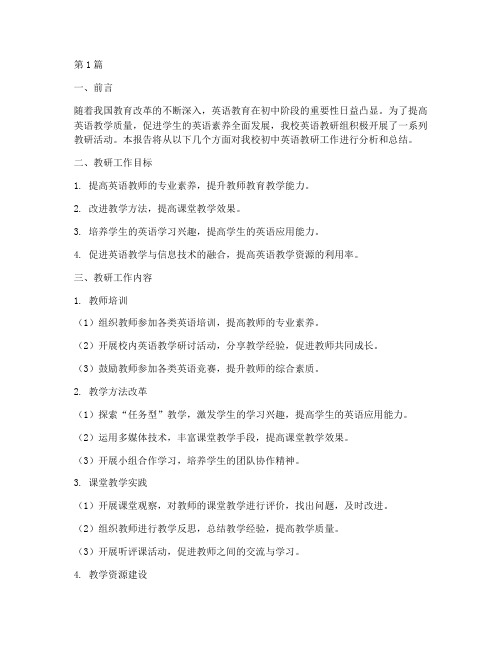
第1篇一、前言随着我国教育改革的不断深入,英语教育在初中阶段的重要性日益凸显。
为了提高英语教学质量,促进学生的英语素养全面发展,我校英语教研组积极开展了一系列教研活动。
本报告将从以下几个方面对我校初中英语教研工作进行分析和总结。
二、教研工作目标1. 提高英语教师的专业素养,提升教师教育教学能力。
2. 改进教学方法,提高课堂教学效果。
3. 培养学生的英语学习兴趣,提高学生的英语应用能力。
4. 促进英语教学与信息技术的融合,提高英语教学资源的利用率。
三、教研工作内容1. 教师培训(1)组织教师参加各类英语培训,提高教师的专业素养。
(2)开展校内英语教学研讨活动,分享教学经验,促进教师共同成长。
(3)鼓励教师参加各类英语竞赛,提升教师的综合素质。
2. 教学方法改革(1)探索“任务型”教学,激发学生的学习兴趣,提高学生的英语应用能力。
(2)运用多媒体技术,丰富课堂教学手段,提高课堂教学效果。
(3)开展小组合作学习,培养学生的团队协作精神。
3. 课堂教学实践(1)开展课堂观察,对教师的课堂教学进行评价,找出问题,及时改进。
(2)组织教师进行教学反思,总结教学经验,提高教学质量。
(3)开展听评课活动,促进教师之间的交流与学习。
4. 教学资源建设(1)收集整理英语教学资源,为教师提供丰富的教学素材。
(2)建立英语教学资源库,提高教学资源的利用率。
(3)鼓励教师开发校本课程,满足学生的个性化需求。
四、教研工作成果1. 教师的专业素养得到提升,教育教学能力不断提高。
2. 课堂教学效果明显改善,学生的学习兴趣和英语应用能力得到提高。
3. 学生在各类英语竞赛中取得优异成绩,学校英语教育品牌得到提升。
4. 教学资源建设取得丰硕成果,为英语教学提供了有力保障。
五、存在问题及改进措施1. 部分教师对英语教学改革的认识不足,教学观念滞后。
改进措施:加强教师培训,提高教师对英语教学改革的认识,更新教学观念。
2. 教学资源不足,影响英语教学效果。
初中英语深度教研报告(3篇)
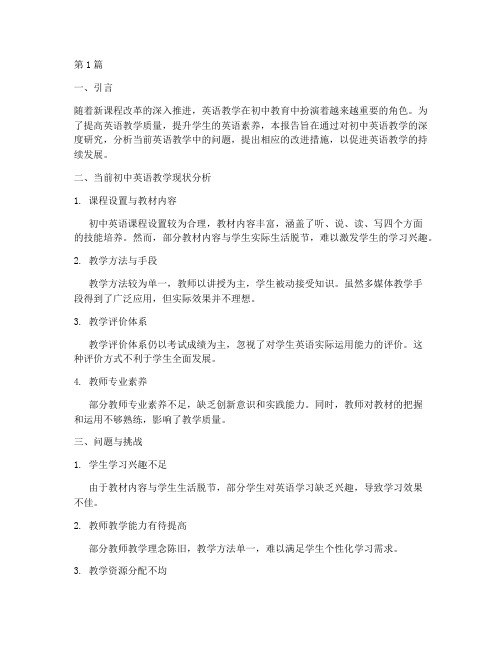
第1篇一、引言随着新课程改革的深入推进,英语教学在初中教育中扮演着越来越重要的角色。
为了提高英语教学质量,提升学生的英语素养,本报告旨在通过对初中英语教学的深度研究,分析当前英语教学中的问题,提出相应的改进措施,以促进英语教学的持续发展。
二、当前初中英语教学现状分析1. 课程设置与教材内容初中英语课程设置较为合理,教材内容丰富,涵盖了听、说、读、写四个方面的技能培养。
然而,部分教材内容与学生实际生活脱节,难以激发学生的学习兴趣。
2. 教学方法与手段教学方法较为单一,教师以讲授为主,学生被动接受知识。
虽然多媒体教学手段得到了广泛应用,但实际效果并不理想。
3. 教学评价体系教学评价体系仍以考试成绩为主,忽视了对学生英语实际运用能力的评价。
这种评价方式不利于学生全面发展。
4. 教师专业素养部分教师专业素养不足,缺乏创新意识和实践能力。
同时,教师对教材的把握和运用不够熟练,影响了教学质量。
三、问题与挑战1. 学生学习兴趣不足由于教材内容与学生生活脱节,部分学生对英语学习缺乏兴趣,导致学习效果不佳。
2. 教师教学能力有待提高部分教师教学理念陈旧,教学方法单一,难以满足学生个性化学习需求。
3. 教学资源分配不均城乡学校之间、不同班级之间教学资源分配不均,影响了教学质量的提高。
4. 家庭教育与学校教育脱节部分家长对英语学习重视不够,导致家庭教育与学校教育脱节,影响了学生的学习效果。
四、改进措施1. 优化课程设置与教材内容根据学生实际需求,优化课程设置,增加与生活相关的教学内容,提高学生的学习兴趣。
2. 创新教学方法与手段采用多样化的教学方法,如任务型教学、合作学习等,激发学生的学习兴趣,提高教学效果。
3. 完善教学评价体系建立多元化的评价体系,注重对学生英语实际运用能力的评价,促进学生的全面发展。
4. 提高教师专业素养加强教师培训,提高教师的专业素养和教学能力,为提高教学质量奠定基础。
5. 优化教学资源配置合理分配教学资源,缩小城乡学校之间、不同班级之间的差距,促进教育公平。
初中英语教育实践研究报告范文

初中英语教育实践研究报告范文全文共12篇示例,供读者参考篇1Title: A Student's Perspective on English Teaching in Middle SchoolIntroductionAs a middle school student, learning English is a huge part of my life. I spend several hours each week in English classes, and it's one of the most important subjects. But how effective are the teaching methods used by my English teachers? In this report, I'll share my thoughts and experiences as a student in the English language classroom.Textbooks and CurriculumThe textbooks we use are pretty standard ones approved by the county school board. They cover grammar, vocabulary, reading comprehension, writing, and some speaking practice. I find the content to be clear and easy to understand most of the time. However, the topics can be a bit dry and boring at times. I wish we had more engaging, real-world examples and dialogues.The curriculum moves at a good pace, introducing new concepts systematically. We build on what we learned previously. What I don't like is the heavy emphasis on preparing for standardized tests. It feels like we spend too much class time on strategies for test-taking rather than actually using and practicing English in meaningful ways.Teaching MethodsMost of my English teachers use a combination of lectures, going over textbook exercises as a class, and giving us homework assignments and quizzes. Occasionally we watch videos or have group activities, but lectures are definitely the main method.I have to admit, the lectures can be really dry and hard to pay attention to, especially after we've already been sitting through hours of other classes that day. The teachers try to make them interactive by asking us questions, but we don't get much opportunity for open discussion or debates.When we do pair or group work, I find it very helpful to practice conversing in English with my classmates. Roleplaying, discussions, and projects are the times when I feel I'm really using and reinforcing what I've learned.Learning EnvironmentThe classroom setup is pretty traditional - rows of desks or tables facing the board and teacher's desk. We sometimesre-arrange the furniture for group work, but not very often. The rooms are reasonably well-equipped with projectors, audio equipment, and decent lighting and temperature control.What I don't like is the lack of opportunities to practice English outside of class time. There aren't any English clubs, immersion events, or partnerships with English speakers in the community. It would be great to have more ways to apply my English skills in real-world environments.Assessment MethodsStudents are primarily assessed through tests, quizzes, homework assignments and classroom participation. We have unit tests for each textbook chapter as well as midterm and final exams. A lot of weight is put on the scores from these standardized tests.While the tests check our grammar, vocabulary and reading abilities, I don't feel they adequately measure our speaking and real-world communication skills. I wish we had moreopportunities for open-ended assignments, presentations, and projects that could demonstrate our overall English proficiency.RecommendationsBased on my experiences as a student, here are some recommendations for improving English teaching in middle schools:Update curriculum with more relevant, engaging topics and materials that show real-world applications of English. This could include podcasts, news articles, video clips and other authentic resources.Allocate more class time for interactive activities like discussions, debates, presentations and projects where students can practice actively using English in spontaneous situations.Offer extracurricular options like English clubs, immersion activities with native speakers, or partnerships with local companies/organizations that use English for students to apply their skills.Revise assessment methods to include more performance-based components like oral exams, presentations and portfolio assignments in addition to traditional tests/quizzes.This will incentivize developing well-rounded communication abilities.Provide teacher training on effective strategies for English language instruction such as task-based learning, communicative approaches and incorporating more technology/multimedia into lessons.ConclusionWhile the foundations of English education in my middle school are solid, I believe there are areas that could be improved to make it a more engaging, productive and practical experience. With some updates to the curriculum, more interactive teaching methods, an enhanced learning environment and revised assessment approaches, we could become more confident and capable English communicators ready for the real world.篇2My English Learning Journey in Middle SchoolIntroductionAs an 8th grader about to graduate from middle school, I've spent the last three years immersed in learning English. Looking back, I've come a long way from those first few classes! English isa core subject here, and my school puts a big emphasis on helping us build solid language skills. In this report, I'll share my experiences, what worked well, what was challenging, and my thoughts on English education in middle schools.My Background and Early ClassesI started learning English basics in elementary school, but everything ramped up when I began 6th grade. At first, the pace and intensity felt overwhelming. We had English class every day, often with separate periods for reading, writing,speaking/listening, and grammar instruction. The vocabulary lists and grammar rules seemed never-ending!Those early classes focused heavily on building our foundational knowledge. We spent a lot of time memorizing vocabulary word lists organized by topic. We also did tons of drill exercises, diagramming sentences, and learning about verb tenses, parts of speech, and the other nitty-gritty grammar details. While tedious at times, I realized later how crucial it was to cement those basics.Engaging Activities That HelpedWhat stands out most in my mind from 6th grade English classes were the engaging activities that broke up the routine.Our teacher was big on games, songs, chants, and other interactive elements to reinforce what we were learning. Vocabulary games like Pictionary, bingo, charades andround-robin word defining were fun ways to solidify word meanings in our minds.For grammar practice, we'd do activities like grammar auctions (bidding on correct sentence examples), grammar rap battles, and team competitions around identifying parts of speech or sentence types. I especially loved the singing and chanting, which made verb conjugations and grammar rules stick through repetition and melody.Appreciating Reading and WritingAs we progressed into 7th and 8th grade, the curriculum expanded from the foundational skills to higher-level reading comprehension, writing, speaking, and analytical skills. We started exploring different genres of literature, from short stories and novels to poetry, plays, and nonfiction articles.At first, I found analyzing literature pretty dry and tedious. However, once I got the hang of strategies like finding the main idea, making inferences, identifying themes and character motivations, I started appreciating literature on a deeper level.Discussions helped bring the texts to life as we shared perspectives and drew out richer meanings.On the writing side, we followed the full process from brainstorming to drafting, revising, editing, and publishing. We learned about different formats like narratives, persuasive essays, research reports, and more. My writing definitely improved through rounds of feedback and having models to emulate. However, I still find citing evidence and developing a smooth logical flow challenging.Conquering the Fear of SpeakingMy biggest struggle has been with the speaking and listening components of English class. As a naturally shy person, I've had to work hard to overcome my fear of public speaking and conversational mistakes. Fortunately, my teachers created a supportive environment with lots of opportunities for lowstakes practice.We did activities like simulated conversations, role plays, debates, presentations, and group projects with an emphasis on speaking up. While nerve-wracking at first, the more I practiced, the more confidence I gained. A breakthrough moment was giving my first big research presentation in 8th grade. While farfrom perfect, getting through it felt like a huge weight off my shoulders.Measuring Progress and Areas for ImprovementBetween regular testing, quizzes, and standardized English exams each year, we got plenty of feedback on our progress across reading, writing, speaking, and listening skills. Overall, my scores put me at or above the expected levels for my grade. However, there's still plenty of room for improvement as I look ahead to high school English classes.My teachers have emphasized areas like expanding my academic vocabulary, varying my sentence structures for better flow, and backing up claims with stronger textual evidence in my writing. For speaking, I need to focus on minimizing filler words, thinking through responses, and projecting more confidence. With listening, I occasionally still struggle to catch every word, especially with unfamiliar accents.Looking AheadEnglish will continue being a major part of my studies throughout high school and beyond. While the journey has felt challenging at times, I'm grateful for how much my skills have grown over these past three years of middle school. Theinteractive activities, opportunities for practice and feedback, and supportive teachers have all played an important part.As I look ahead, I know I'll need to stay dedicated to expanding my vocabulary, perfecting my grammar, reading a variety of complex texts, and honing my communication abilities. English fluency will open up many opportunities for me, from academics to career paths. With continued hard work and the right learning approach, I'm confident I can achieve the level of English mastery I'll need for future success.篇3Title: Learning English in Middle School - A Kid's ViewIntroductionHi there! My name is Jenny and I'm a 5th grader at Oakwood Elementary School. I love learning new things, especially about different languages and cultures. This year, I did a research project all about how English is taught in middle schools. I interviewed teachers, observed some classes, and looked at textbooks and lesson plans. I thought it would be really cool to share what I learned with you!How English is TaughtIn the middle schools I looked at, English class happens almost every day for around 50 minutes. The classes have between 20-30 students of different English levels. From what I saw, teachers use a mix of techniques like:Vocabulary Lists - Students get lists of new vocab words to learn meanings, pronunciation, etc. The words are often connected to the unit theme.Reading Passages - There are longer texts that explore different topics. Students read and answer comprehension questions.Grammar Study - Covering English grammar rules for things like verb tenses, sentence structure, etc. Lots of practice exercises.Speaking Activities - Pair and group conversational activities let students practice speaking skills.Writing Assignments - Short paragraphs and essays allowing practice of writing skills.Multimedia - Using videos, online exercises, language apps to engage students differently.Projects - Longer assignments like presenting, making videos/posters to apply skills.Depending on the school, they either have one English teacher or sometimes switch between teachers for different units/skills.Popular Textbooks and MaterialsThe most widely used textbook series I saw was published by Oxford University Press called "Incredible English." It comes with texts, workbooks, multimedia resources, and teacher's manuals. Another popular one was "Top Notch" from Pearson publishers.Schools seemed to supplement the main textbooks with lots of other materials too. Things like reading libraries with novels, short stories, newspapers, and magazines. Or online exercise websites and language learning apps. Some used videos from YouTube channels like "English Class V.O.A. Learning English" or "BBC Learning English."Many classrooms had educational posters and games related to vocabulary, grammar, reading strategies, etc. Teachers get pretty creative finding engaging resources to use!Challenges of Learning EnglishFrom talking to students, some of the biggest challenges seem to be:Pronunciation - Speaking clearly with proper pronunciation of certain English sounds.Vocabulary - Learning and retaining all the new vocabulary words.Grammar - Understanding and applying all the grammar rules correctly.Speaking Confidence - Feeling shy or nervous to speak out and practice conversational skills.Listening Comprehension - Understanding Englishaudio/video sources can be difficult.Different students struggle more with certain aspects based on their personal learning styles and strengths. Consistent practice seems to be key for improving overall.What I Think About ItIn my opinion, learning English seems both really fun and really challenging at the same school level. I can see how the variety of activities like reading, writing, speaking, listening would allow students to practice using English in different ways. The multimedia and group/pair work also looks engaging.However, I imagine having to learn all those grammar rules plus tons of new vocabulary would feel overwhelming at times. Speaking out and doing presentations also seems prettynerve-wracking, especially in front of others. I'm already a bit nervous about English classes in middle school!I think the teachers have a tough job making classes interesting while covering so much material. But it seems like most try to balance textbook work with other interactive resources. Keeping students motivated and providing enough practice opportunities is probably difficult.Overall though, middle school seems like a great time to build solid English foundations. The lessons look designed to develop well-rounded skills in all areas through diverse techniques. As challenging as it might be, developing abilities at that age will definitely pay off down the road.ConclusionWell, that's my kid's perspective on how English is commonly taught in middle schools! I had a blast researching this topic and getting a preview of what's to come. While it won't be easy, I'm really looking forward to continuing my English studies soon. Being bilingual opens up so many opportunities.I hope you found my observations interesting and insightful. Learning a new language allows connecting to different cultures and viewpoints. It's such a valuable lifelong skill. I'm grateful my school district makes English education a priority starting at the middle level. Maybe I'll be an English teacher someday too!篇4My Big Brother's Important English ExamMy big brother Xiao Ming just took a really important English exam called the Anqing High School Senior Year Mock Exam. It was a big deal because it helps get ready for the even bigger gaokao exam that all students have to take to get into university in China. Xiao Ming has been studying so hard for months!When he got his score back, he was pretty happy but also a little disappointed. He got a 78 out of 100 on the English portion. That's a pretty good score, but Xiao Ming was hoping for higher since English is one of his best subjects usually.My parents have different opinions about the score. My mom thinks 78 is excellent and she's proud of Xiao Ming for working so hard. She says the mock exam is just practice and the real gaokao test is what matters most. My dad though, he wantsXiao Ming to keep pushing himself to get an even higher score. Dad thinks if he gets into a prestigious university, it will lead to a good stable job and better life for our family in the future.I don't fully understand what the big deal is, since I'm just a little kid in elementary school. But I know it's very important for growing up and becoming an adult in China. I'll be taking that gaokao test myself in just a few years!Xiao Ming has been going over his exam very carefully to learn from his mistakes. He showed me the different sections. There was listening, reading, grammar, writing and translation. He told me the writing section, where you have to write an essay in English, is one of the hardest parts.For the listening, you have to listen to recordings of English speakers and answer questions. Xiao Ming said his English listening skills are pretty good from watching movies and shows, but there were still some tough sections where the speakers talked really fast or used slang he wasn't familiar with.The reading section had long passages to read and answer questions about. Xiao Ming struggled with some of the super long vocabulary words and idioms he hadn't seen before. He told me you have to have a really large English vocabulary to do well on that part.The grammar questions were mostly about verb tenses, parts of speech, clauses and other grammar rules. Xiao Ming has learned English grammar for many years so that was one of his stronger sections, though he said even native English speakers sometimes struggle with all the crazy grammar rules and exceptions.Then for writing the essay, you have to write a longer structured piece, usually an expository or argumentative essay. You're graded on your ideas, organization, grammar, vocabulary and more. Xiao Ming finds it pretty difficult to write a long coherent piece with few mistakes, especially under timed pressure of the exam.The final translation section asked students to translate sentences and short paragraphs between English and Chinese. Xiao Ming said this was pretty hard because you really need to understand the deeper meaning and conventions in both languages to translate accurately.Overall, Xiao Ming was okay with his 78 score, but he's realizing he needs to work even harder now to get an even higher score on the real gaokao exam. He's going to study English vocabulary using flashcards, read more books andarticles to improve reading comprehension, practice listening to TV shows and podcasts, and do lots of timed writing practice.I tried to give Xiao Ming a pep talk to cheer him up. I told him I think he's amazing at English already and so smart! He works incredibly hard, way harder than me. I said a 78 is still a really good score and he should be proud. I know Xiao Ming is doubling down to get a 90+ on the real test, but I reminded him that his score doesn't define who he is. As long as he tries his best, that's what matters most.I look up to Xiao Ming so much. Seeing how intensely he prepares for these huge exams makes me realize I'll need to work that hard too when I'm in high school. For now though, I just focus on the math tests in my 3rd grade class! I'm rooting for Xiao Ming to ace the gaokao. I have no doubt he'll make our family proud, no matter what score he gets. Xiao Ming, jiayou!篇5初中英语教育实践研究报告引言大家好!我是一名小学生,我今天想和大家分享一下我对初中英语教育的实践研究。
初中英语教研课例(3篇)

第1篇一、课例背景随着我国英语课程改革的不断深入,英语阅读教学在英语教学中占据越来越重要的地位。
阅读理解是英语学习中的重要环节,它不仅有助于提高学生的语言能力,还能培养学生的思维品质和文化意识。
为了提高初中英语阅读教学质量,本节课以阅读理解策略教学为主题,通过分析阅读理解策略,探讨如何有效地提高学生的阅读理解能力。
二、教学目标1. 知识与技能目标:学生能够掌握阅读理解的基本策略,提高阅读速度和准确性。
2. 过程与方法目标:通过合作学习、探究学习等方式,培养学生的阅读兴趣和自主学习能力。
3. 情感态度与价值观目标:激发学生对英语阅读的兴趣,提高学生的文化素养。
三、教学重难点1. 教学重点:掌握阅读理解的基本策略,提高阅读速度和准确性。
2. 教学难点:培养学生的阅读兴趣,提高学生的文化素养。
四、教学过程(一)导入1. 播放一段英语短片,让学生初步感知英语阅读的趣味性。
2. 引导学生思考:在阅读过程中,我们应该如何提高阅读速度和准确性?(二)新课导入1. 分析阅读理解的基本策略:(1)预读:在阅读文章之前,快速浏览文章标题、图片、小标题等,预测文章内容。
(2)略读:快速浏览文章,把握文章大意。
(3)细读:仔细阅读文章,理解文章细节。
(4)查读:针对特定信息进行查找。
2. 结合具体实例,讲解阅读理解策略在阅读过程中的应用。
(三)课堂活动1. 分组讨论:学生根据所学策略,分析一篇短文,找出文章中的关键词汇、短语和句子结构。
2. 合作学习:学生以小组为单位,共同完成一篇阅读理解练习,互相讨论、交流心得。
3. 探究学习:学生根据所学策略,选择一篇课外阅读材料,进行自主阅读,并撰写读后感。
(四)课堂小结1. 回顾本节课所学内容,强调阅读理解策略的重要性。
2. 引导学生反思:在实际阅读过程中,如何运用所学策略提高阅读效果?(五)作业布置1. 完成课后阅读练习,巩固所学策略。
2. 选择一篇课外阅读材料,进行自主阅读,并撰写读后感。
初中英语课例研究报告(正稿)
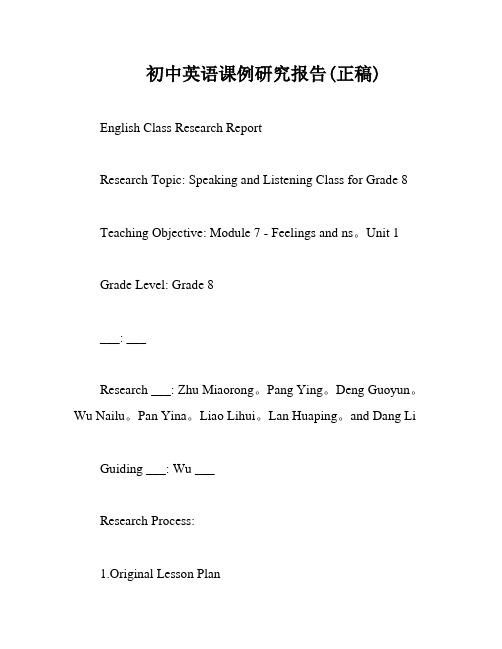
初中英语课例研究报告(正稿)English Class Research ReportResearch Topic: Speaking and Listening Class for Grade 8Teaching Objective: Module 7 - Feelings and ns。
Unit 1Grade Level: Grade 8___: ___Research ___: Zhu Miaorong。
Pang Ying。
Deng Guoyun。
Wu Nailu。
Pan Yina。
Liao Lihui。
Lan Huaping。
and Dang LiGuiding ___: Wu ___Research Process:1.Original Lesson PlanAfter more than a year of ___ materials。
___ process。
even with the use of new materials。
This results in students not ___。
our main research topic is how to design ___。
where students ethe main focus of the ___ students how to express their ___.Topic Background: This module focuses on feelings and ns。
mainly discussing food。
reviews。
and ns of people。
Studentswill understand the use of sensory verbs and learn about the nal attitudes and preferences of Sally。
a British girl。
This topic is___' interests。
初中英语教学案例分析报告范文6篇
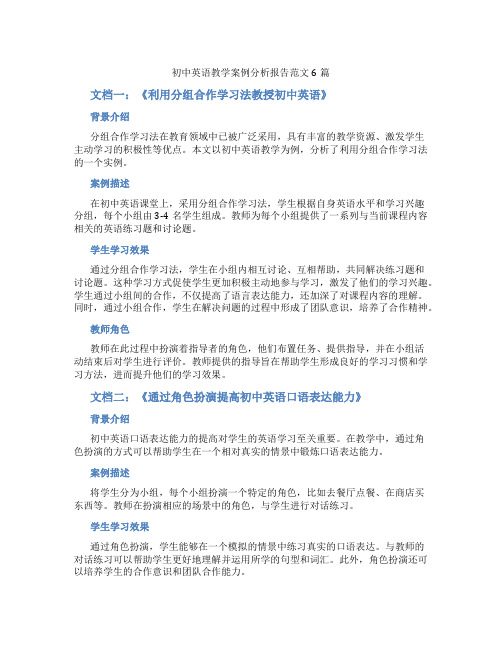
初中英语教学案例分析报告范文6篇文档一:《利用分组合作学习法教授初中英语》背景介绍分组合作学习法在教育领域中已被广泛采用,具有丰富的教学资源、激发学生主动学习的积极性等优点。
本文以初中英语教学为例,分析了利用分组合作学习法的一个实例。
案例描述在初中英语课堂上,采用分组合作学习法,学生根据自身英语水平和学习兴趣分组,每个小组由3-4名学生组成。
教师为每个小组提供了一系列与当前课程内容相关的英语练习题和讨论题。
学生学习效果通过分组合作学习法,学生在小组内相互讨论、互相帮助,共同解决练习题和讨论题。
这种学习方式促使学生更加积极主动地参与学习,激发了他们的学习兴趣。
学生通过小组间的合作,不仅提高了语言表达能力,还加深了对课程内容的理解。
同时,通过小组合作,学生在解决问题的过程中形成了团队意识,培养了合作精神。
教师角色教师在此过程中扮演着指导者的角色,他们布置任务、提供指导,并在小组活动结束后对学生进行评价。
教师提供的指导旨在帮助学生形成良好的学习习惯和学习方法,进而提升他们的学习效果。
文档二:《通过角色扮演提高初中英语口语表达能力》背景介绍初中英语口语表达能力的提高对学生的英语学习至关重要。
在教学中,通过角色扮演的方式可以帮助学生在一个相对真实的情景中锻炼口语表达能力。
案例描述将学生分为小组,每个小组扮演一个特定的角色,比如去餐厅点餐、在商店买东西等。
教师在扮演相应的场景中的角色,与学生进行对话练习。
学生学习效果通过角色扮演,学生能够在一个模拟的情景中练习真实的口语表达。
与教师的对话练习可以帮助学生更好地理解并运用所学的句型和词汇。
此外,角色扮演还可以培养学生的合作意识和团队合作能力。
教师在角色扮演中既是引导者,也是参与者。
他们需要起到积极引导学生参与角色扮演的作用,并及时给予学生反馈和指导。
教师还可以在角色扮演活动结束后进行整体的总结和评价。
文档三:《利用多媒体教具提高初中英语听力能力》背景介绍初中英语听力是学生英语学习中的重要环节。
初中生英语课题研究报告模板
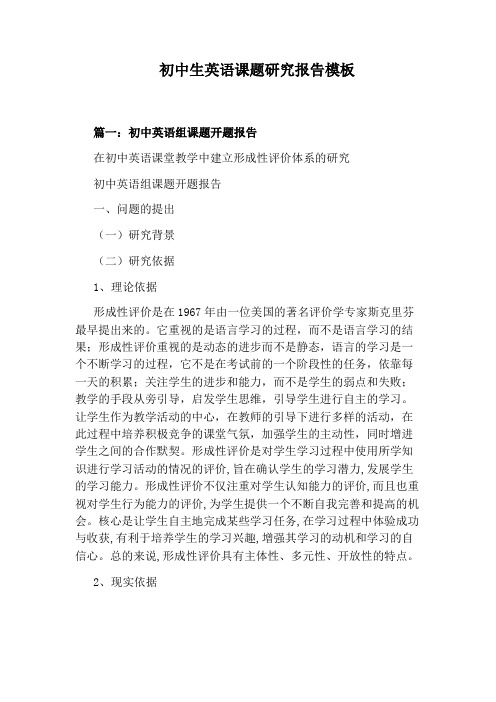
初中生英语课题研究报告模板篇一:初中英语组课题开题报告在初中英语课堂教学中建立形成性评价体系的研究初中英语组课题开题报告一、问题的提出(一)研究背景(二)研究依据1、理论依据形成性评价是在1967年由一位美国的著名评价学专家斯克里芬最早提出来的。
它重视的是语言学习的过程,而不是语言学习的结果;形成性评价重视的是动态的进步而不是静态,语言的学习是一个不断学习的过程,它不是在考试前的一个阶段性的任务,依靠每一天的积累;关注学生的进步和能力,而不是学生的弱点和失败;教学的手段从旁引导,启发学生思维,引导学生进行自主的学习。
让学生作为教学活动的中心,在教师的引导下进行多样的活动,在此过程中培养积极竞争的课堂气氛,加强学生的主动性,同时增进学生之间的合作默契。
形成性评价是对学生学习过程中使用所学知识进行学习活动的情况的评价,旨在确认学生的学习潜力,发展学生的学习能力。
形成性评价不仅注重对学生认知能力的评价,而且也重视对学生行为能力的评价,为学生提供一个不断自我完善和提高的机会。
核心是让学生自主地完成某些学习任务,在学习过程中体验成功与收获,有利于培养学生的学习兴趣,增强其学习的动机和学习的自信心。
总的来说,形成性评价具有主体性、多元性、开放性的特点。
2、现实依据在初中英语课堂教学中,教师对学生听、说、读、写四项语言技能的评价,并不是只根据考试成绩来衡量学生,注重学习结果的终结性评价。
如何在初中英语课堂教学中(三)研究目的和意义英语教师对每个学生英语学习情况的评价,不只是通过传统的考试或听写成绩来考查。
而是注重在培养学生外语知识的运用能力,即学生学习英语的听、说、读、写等各项技能的过程中,注重过程、动态的形成性评价,体现教师在英语课堂教学评价方式上的多元性、多样性。
从而让每一位学生认识到自己的智能优势领域,为每一位学生的个性与创造性发展留下足够空间,从而使其对英语学习活动树立自信。
二、研究的基本内容我们将从初一“说”的技能培养、初二“听”和“读”的技能的培养、初三“写”的技能的培养上,通过初中英语课堂教学实践,总结英语课堂教学评价中形成性评价的方法,例如学生自我评价、合作评价、教师评价、学生档案等形成性评价方法。
初中英语案例分析报告范文6篇怎么写
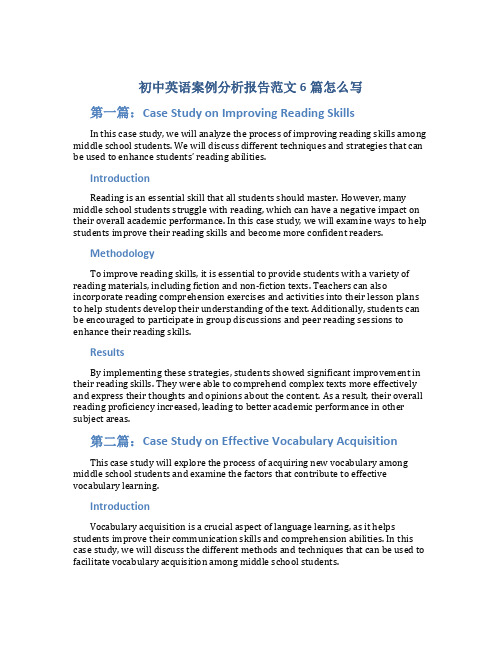
初中英语案例分析报告范文6篇怎么写第一篇:Case Study on Improving Reading SkillsIn this case study, we will analyze the process of improving reading skills among middle school students. We will discuss different techniques and strategies that can be used to enhance students’ reading abilities.IntroductionReading is an essential skill that all students should master. However, many middle school students struggle with reading, which can have a negative impact on their overall academic performance. In this case study, we will examine ways to help students improve their reading skills and become more confident readers.MethodologyTo improve reading skills, it is essential to provide students with a variety of reading materials, including fiction and non-fiction texts. Teachers can also incorporate reading comprehension exercises and activities into their lesson plans to help students develop their understanding of the text. Additionally, students can be encouraged to participate in group discussions and peer reading sessions to enhance their reading skills.ResultsBy implementing these strategies, students showed significant improvement in their reading skills. They were able to comprehend complex texts more effectively and express their thoughts and opinions about the content. As a result, their overall reading proficiency increased, leading to better academic performance in other subject areas.第二篇:Case Study on Effective Vocabulary AcquisitionThis case study will explore the process of acquiring new vocabulary among middle school students and examine the factors that contribute to effective vocabulary learning.IntroductionVocabulary acquisition is a crucial aspect of language learning, as it helps students improve their communication skills and comprehension abilities. In this case study, we will discuss the different methods and techniques that can be used to facilitate vocabulary acquisition among middle school students.MethodologyTo enhance vocabulary acquisition, teachers can introduce students to new words through context-based learning activities, such as reading passages or watching videos. Students can also be encouraged to create flashcards or engage in vocabulary games to reinforce their understanding of the new words. Additionally, regular vocabulary quizzes and assessments can be used to track students’ progress and identify areas for improvement.ResultsThrough the implementation of these strategies, students demonstrated a significant improvement in their vocabulary acquisition. They were able to recall and use new words in context, leading to enhanced communication skills and overall language proficiency.第三篇:Case Study on Developing Writing SkillsIn this case study, we will analyze the process of developing writing skills among middle school students and explore effective strategies for improving students’ writing abil ities.IntroductionWriting is a fundamental skill that allows students to express their thoughts and ideas effectively. In this case study, we will discuss the different techniques and methods that can be used to help students enhance their writing skills and become more proficient writers.MethodologyTo develop writing skills, teachers can provide students with writing prompts and assignments that encourage them to explore different genres and styles of writing. Students can also be encouraged to participate in peer reviewing sessions to receive feedback on their writing and improve their editing skills. Additionally, teachers can provide individualized guidance and support to help students develop their writing skills at their own pace.ResultsBy implementing these strategies, students showed significant improvement in their writing skills. They were able to write more cohesively and fluently, demonstrating a greater understanding of grammar and sentence structure. As a result, their writing proficiency improved, leading to better academic performance in language arts and other subject areas.第四篇:Case Study on Effective Listening SkillsThis case study will examine the process of developing effective listening skills among middle school students and explo re strategies for improving students’ listening abilities.IntroductionListening is a critical skill that plays a key role in communication and language learning. In this case study, we will discuss the importance of developing effective listening skills and explore techniques that can be used to help students become better listeners.MethodologyTo enhance listening skills, teachers can incorporate listening activities and exercises into their lesson plans, such as listening to audio recordings or watching videos. Students can also be encouraged to participate in group discussions and oral presentations to practice active listening and improve their comprehension skills. Additionally, teachers can provide students with opportunities to listen to a variety of accents and speech patterns to enhance their listening proficiency.ResultsThrough the implementation of these strategies, students demonstrated a significant improvement in their listening skills. They were able to follow instructions more effectively, retain information from lectures and presentations, and engage in meaningful conversations with their peers. As a result, their overall listening proficiency increased, leading to better communication skills and academic performance.第五篇:Case Study on Enhancing Speaking SkillsIn this case study, we will analyze the process of enhancing speaking skills among middle school students and explore effective strategies for improving students’ oral communication abilities.IntroductionSpeaking is a crucial aspect of language learning that allows students to express themselves and communicate with others. In this case study, we will discuss the different techniques and methods that can be used to help students enhance their speaking skills and become more confident speakers.MethodologyTo enhance speaking skills, teachers can provide students with opportunities to practice speaking in a variety of contexts, such as debates, presentations, and role-playing activities. Students can also be encouraged to engage in group discussions and peer speaking sessions to improve their conversational skills. Additionally, teachers can provide constructive feedback and guidance to help students overcome their speaking challenges and build confidence in their speaking abilities.ResultsBy implementing these strategies, students showed significant improvement in their speaking skills. They were able to articulate their thoughts and ideas more clearly, participate actively in class discussions, and deliver engaging presentations. As a result, their oral communication skills improved, leading to better interaction with their peers and increased confidence in speaking English.第六篇:Case Study on Integrated Language Skills DevelopmentThis case study will explore the process of integrating the four language skills –reading, writing, listening, and speaking – to enhance overall language proficiency among middle school students.IntroductionLanguage learning involves the development of multiple skills, including reading, writing, listening, and speaking. In this case study, we will discuss the importance of integrating these language skills and explore strategies that can be used to promote comprehensive language development among students.MethodologyTo integrate language skills, teachers can design interdisciplinary lesson plans that incorporate reading, writing, listening, and speaking activities. Students can be encouraged to work on projects that require them to use all four language skills, such as creating multimedia presentations or conducting debates. Additionally, teachers can provide students with opportunities to practice integrated language skills in real-life situations to enhance their language proficiency.ResultsThrough the implementation of these strategies, students demonstrated a significant improvement in their overall language proficiency. They were able to apply their reading, writing, listening, and speaking skills in a variety of contexts, leading to enhanced communication abilities and academic performance. As a result, students became more confident and proficient in using English for academic and everyday purposes.以上为初中英语案例分析报告范文6篇的文档内容,希望对您撰写相关报告提供帮助。
论初中英语课堂教学研究报告6篇
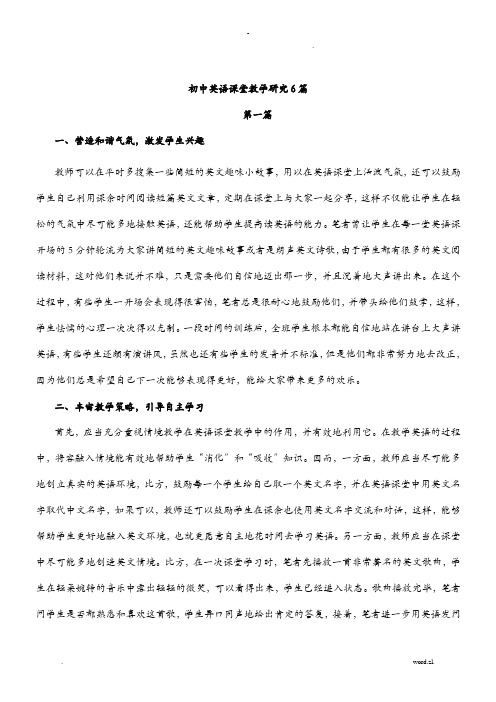
初中英语课堂教学研究6篇第一篇一、营造和谐气氛,激发学生兴趣教师可以在平时多搜集一些简短的英文趣味小故事,用以在英语课堂上活泼气氛,还可以鼓励学生自己利用课余时间阅读短篇英文文章,定期在课堂上与大家一起分享,这样不仅能让学生在轻松的气氛中尽可能多地接触英语,还能帮助学生提高读英语的能力。
笔者曾让学生在每一堂英语课开场的5分钟轮流为大家讲简短的英文趣味故事或者是朗声英文诗歌,由于学生都有很多的英文阅读材料,这对他们来说并不难,只是需要他们自信地迈出那一步,并且沉着地大声讲出来。
在这个过程中,有些学生一开场会表现得很害怕,笔者总是很耐心地鼓励他们,并带头给他们鼓掌,这样,学生怯懦的心理一次次得以克制。
一段时间的训练后,全班学生根本都能自信地站在讲台上大声讲英语,有些学生还颇有演讲风,虽然也还有些学生的发音并不标准,但是他们都非常努力地去改正,因为他们总是希望自己下一次能够表现得更好,能给大家带来更多的欢乐。
二、丰富教学策略,引导自主学习首先,应当充分重视情境教学在英语课堂教学中的作用,并有效地利用它。
在教学英语的过程中,将容融入情境能有效地帮助学生“消化〞和“吸收〞知识。
因而,一方面,教师应当尽可能多地创立真实的英语环境,比方,鼓励每一个学生给自己取一个英文名字,并在英语课堂中用英文名字取代中文名字,如果可以,教师还可以鼓励学生在课余也使用英文名字交流和对话,这样,能够帮助学生更好地融入英文环境,也就更愿意自主地花时间去学习英语。
另一方面,教师应当在课堂中尽可能多地创造英文情境。
比方,在一次课堂学习时,笔者先播放一首非常著名的英文歌曲,学生在轻柔婉转的音乐中露出轻轻的微笑,可以看得出来,学生已经进入状态。
歌曲播放完毕,笔者问学生是否都熟悉和喜欢这首歌,学生异口同声地给出肯定的答复,接着,笔者进一步用英语发问学生都喜欢什么类型的歌曲,这样,课堂教学主题自然就引出来了,通过创设这样的教学情境,学生能够更好地去“体味〞和“享受〞英语,在这种轻松而愉悦的情境下,学生思维也能得到更好地发散,这种轻松和愉悦的情感也能有效地推动学生留意生活中的英语,并乐于自主学习。
初中生英语课题研究报告模板

初中生英语课题研究报告模板篇一:初中英语课题研究报告一课题提出的实施背景“新英语课程目标”把阅读技能目标描述为:朗读各种文体、英语诗词、报刊杂志、原著及各种商品说明书等非专业技术性资料并理解大意。
根据情境、上下文、构词法、句子结构来猜测生词及词组的意思,新教材、新课标明显英语阅读能力的培养上都提出了比以往更高的要求。
对阅读要求的增加是非常符合当今中学生英语运用能力的发展方向,我校是一所农村中学,学生基础差,有的连26个字母都不认识。
开办之初英语教学状况堪忧,近几年,在教学中却发现学生在阅读题目上失分较多,实际教学了解到英语阅读现状不容乐观。
基于这种认识,学校英语教研组相应部门的倡导,积极加入了“初中英语阅读实验课题研究”并把我带的(4)班与别的老师(3)班为实验进行了尝试。
二:课题实施内容1浏览全文、了解大意遇到一篇文章,要在短时间内快速阅读一遍,以对全文有一个总体印象,了解它的主旨大意,不要拿到材料立即就逐句逐字阅读,拿到一份阅读材料,也可以先看材料后的问题,然后带着问题,抓住特定信息,使做题具有一定的方向性和选择性。
2。
猜测生词,记时阅读在阅读过程中常常会碰到一些生词。
要善于利用已提供的信息去推测未只知信息,结合上下文来推测词义。
不必见到生词就查词典,这样可以保持阅读的连贯性,不致于影响阅读的速度和对文章的整体理解。
那么,碰到生词该怎么办呢?可以采用下列三种办法来处理:如果是专有名词,一般可以根据上下文来判断它是人名还是地名,或是其它组织的名称。
对于这些词不认识关系不大,只要知道它代表什么就行另有一些单词可以根据上下文的内容、语气来判断它们的含义。
如果遇到个别难以猜测其义而又会影响到对文章理解的单词,就应该查阅一下词典3养成良好的阅读习惯阅读时一定要专心致志、聚精会神,不能边聊天边阅读,也不能边阅读边干别的事。
学会独立地读,默默地读,不受他人干扰;阅读时不摇头晃脑、东张西望、避免指读;阅读后写些心得体会等。
初中英语课例分析报告范文

初中英语课例分析报告范文In a middle school English class, the teacher can use a variety of teaching methods to engage students in the learning process. For example, the teacher can start the class with a warm-up activity such as a quick vocabulary quiz or a discussion question related to the day's topic. This can help activate prior knowledge and get students thinking about the topic at hand.Next, the teacher can introduce the new material using a combination of visuals, real-life examples, and hands-on activities. By appealing to different learning styles, the teacher can ensure that all students are able to understand and retain the information being presented. For example, the teacher can use flashcards to introduce new vocabulary words, show videos or pictures to illustrate complex concepts, andengage students in group work or role-playing activities to practice using the new language.Throughout the lesson, the teacher can also incorporate opportunities for students to practice their listening, speaking, reading, and writing skills. This can be done through activities such as listening to audio recordings, participating in class discussions, reading short passages, and writing short stories or essays. By providing a well-rounded language learning experience, the teacher can help students develop all aspects of their language skills.At the end of the lesson, the teacher can assess student understanding through activities such as quizzes, tests, or group presentations. This can help the teacher gauge whether students have mastered the material and identify any areas that may need further review. Additionally, providing feedback to students on their performance can help motivate them to continue improving their English skills.Overall, by using a combination of engaging activities, varied teaching methods, and assessments, a middle school English teacher can create a dynamic and effective learning environment for students. This can help students develop their language skills, build confidence in their abilities, and foster a love of learning that will serve them well in the future.。
课例研究报告范文初中英语

课例研究报告范文初中英语1. 引言本文旨在探讨在初中英语教学中应用课例研究的有效性和可行性。
通过对一位初中学生在英语学科的学习过程进行观察和分析,我们将展示课例研究在教学实践中的影响力,并解释其对学生语言能力提升的积极作用。
2. 研究背景在传统的初中英语教学中,学生通常以记忆为主的方式学习单词和语法知识,而在实际应用中却难以灵活运用所学内容。
因此,教育界意识到需要寻求一种更有效的教学方法以提高学生的语言能力。
课例研究是一种基于案例和实践的教学方法,旨在通过实际情境的应用来激发学生的学习兴趣和提高学习效果。
本研究将探索如何在初中英语教学中应用课例研究,以及其对学生的影响。
3. 研究方法本研究采用了观察和记录的方法,通过对一位初中学生的英语学习过程进行跟踪观察,收集并记录学生的学习行为以及学习成果。
4. 研究结果在观察和记录学生的学习过程中,我们发现了以下几个关键结果:4.1 学生参与度的提高通过课例研究的应用,学生更加主动地参与到学习过程中。
他们在案例的引导下,能够思考和分析问题,并在小组合作中展示自己独特的见解。
学生们展示出了更高的学习兴趣和积极性。
4.2 学生语言能力的提升在传统的教学模式中,学生通常只是机械地记住语法规则和单词,然而他们却难以将这些知识运用到实际场景中。
通过课例研究,学生们学会了如何运用所学知识来解决实际问题,提高了他们的语言能力。
他们能够更自信地表达自己的观点,扩展了词汇量,并学会运用语法规则。
4.3 学生合作与交流能力的提高课例研究的应用还促进了学生之间的合作与交流能力的提高。
在小组合作的过程中,学生们需要相互合作、分享和讨论,这培养了他们的团队合作精神和沟通能力。
5. 讨论与结论本研究表明在初中英语教学中应用课例研究有助于提高学生参与度、语言能力和合作交流能力。
通过实际情境的应用,课例研究能够激发学生的学习兴趣,培养学生的思考和解决问题的能力。
然而,课例研究也存在一些挑战,如时间和资源的限制、学生对新教学方法的接受程度等。
初中英语课例研究报告(正稿)

英语课例研究报告研究主题:初二英语听说课教学课目:Module7 Feelin gs and impres sions Unit1教学年级:初二年级执教教师:吴鹏程研究教师:朱妙容庞英邓国云鄔乃禄潘艺娜廖理会蓝华萍党莉指导老师: 吴凌羽研究过程:一、原始课例回顾我们一年多的教学实践,又认真观摩了多节新教材的研讨课,我们发现虽然使用了新教材,但在Spea king教学过程中仍受传统模式的干扰。
导致学生在“说”课堂上动口,动脑意识不强。
那么教师如何设计“Speaki ng”的教学,使得课堂气氛活跃,让学生真正成为教学主体,在教学过程中确确实实地“动”起来就成为我们研究的主要内容。
活动内容:通过本模块的学习,学生可以学会表达自己的感觉和印象。
话题背景:本模块以感觉与印象为话题, 内容主要是谈论对食物等的感觉、评论以及对人的印象等。
了解表感觉和知觉的系动词的用法;了解英国女孩 Sally的情感态度和喜好,很符合学生的兴趣,语言实践活动比较好开展。
学生可以围绕这一话题进行大量的听、说、读、写方面的语言实践活动。
阅读的重点在于理解,在此基础上学会一些描述人长相和性格的表达方式,包括句式和一些形容词。
教学目的:通过谈论感觉与印象训练学生的听、说、读、写能力,掌握使用表感觉和知觉系动词和系表结构,养成正确表达感觉与印象的能力。
教学重点:1. 能正确使用表感觉和知觉的系动词:sound, smell, look, taste, feel; 掌握句子的系表结构:link verb+adj.2. 能够对食物的味道、人的印象等进行评论。
教学难点:1、掌握一些句型的用法2、如何提高学生的口语能力教学方法:分组讨论,使学生自由交谈,然后分角色表演。
初中英语课例分析报告

初中英语课例分析报告简介本文旨在对一堂初中英语课例进行分析,通过对课堂教学过程、教师教学策略以及学生表现等方面的观察和分析,旨在提供对该课例的全面评估和建议,以促进课堂教学的质量改进。
课堂背景该节课是一节初中九年级英语阅读课,班级人数约为45人。
学生的英语水平整体较为良好,但对于阅读理解题目的分析和解答能力仍然存在一定的差距。
教师为一名经验丰富的英语教师,以提高学生的阅读能力为主要目标。
教学目标•培养学生阅读理解的能力,包括学生对文本内容的理解、逻辑分析和细节把握。
•发展学生的批判思维能力,培养学生对问题的思考和分析能力。
•激发学生的学习兴趣,培养学生对英语学习的积极态度。
课堂教学过程•引入:教师通过展示一张激发学生学习兴趣的图片,引入课堂话题,并通过简单的问答等方式激发学生的学习兴趣。
•预习巩固:教师设计了一道与课文主题相关的预习题,让学生回顾和巩固之前学过的知识点,并为接下来的学习做好准备。
•阅读活动:教师在课堂分发了一篇阅读材料,要求学生独立阅读,并在阅读过程中标出自己的疑惑和重点。
随后,教师组织学生进行小组合作,让学生在小组内分享自己的疑惑,并互相讨论解答。
•课堂讲解:教师在学生小组讨论结束后,对学生的疑惑进行整理和讲解。
教师通过解读难点词汇、逐句解读以及讲解阅读策略等方式,帮助学生更好地理解课文内容。
•互动讨论:教师通过提出问题和引导学生进行互动讨论,培养学生的批判思维能力和英语口语表达能力。
•提问反馈:在课堂最后,教师对学生进行提问,并对学生的反馈进行评价和指导,以巩固学生的学习效果。
教师教学策略评价教师在本节课的教学中采用了多种教学策略,其中包括:•引导兴趣:教师通过图片和问答等方式引导学生对课文内容产生兴趣,激发学生的学习积极性。
•多元活动:教师采用了预习巩固、阅读活动、小组讨论、课堂讲解等多种活动形式,使学生能够在不同的情境中进行学习,提高学生的主动参与度。
•个性化辅导:教师在课堂分发的阅读材料中设计了一些挑战性问题,鼓励学生独立思考和解决问题,提高学生的自主学习能力。
初中英语教学教研报告(3篇)
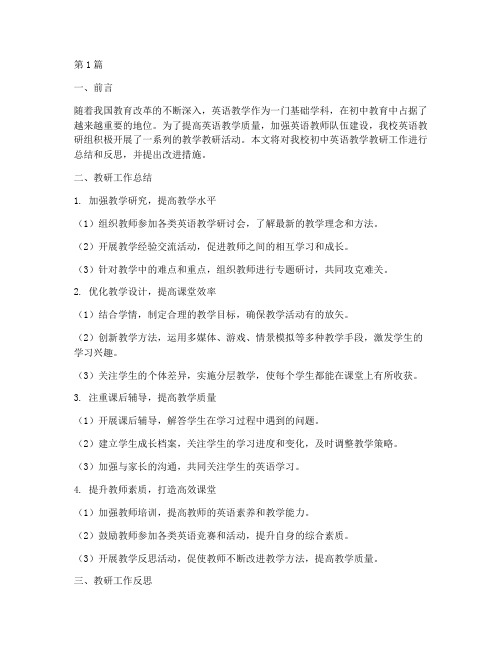
第1篇一、前言随着我国教育改革的不断深入,英语教学作为一门基础学科,在初中教育中占据了越来越重要的地位。
为了提高英语教学质量,加强英语教师队伍建设,我校英语教研组积极开展了一系列的教学教研活动。
本文将对我校初中英语教学教研工作进行总结和反思,并提出改进措施。
二、教研工作总结1. 加强教学研究,提高教学水平(1)组织教师参加各类英语教学研讨会,了解最新的教学理念和方法。
(2)开展教学经验交流活动,促进教师之间的相互学习和成长。
(3)针对教学中的难点和重点,组织教师进行专题研讨,共同攻克难关。
2. 优化教学设计,提高课堂效率(1)结合学情,制定合理的教学目标,确保教学活动有的放矢。
(2)创新教学方法,运用多媒体、游戏、情景模拟等多种教学手段,激发学生的学习兴趣。
(3)关注学生的个体差异,实施分层教学,使每个学生都能在课堂上有所收获。
3. 注重课后辅导,提高教学质量(1)开展课后辅导,解答学生在学习过程中遇到的问题。
(2)建立学生成长档案,关注学生的学习进度和变化,及时调整教学策略。
(3)加强与家长的沟通,共同关注学生的英语学习。
4. 提升教师素质,打造高效课堂(1)加强教师培训,提高教师的英语素养和教学能力。
(2)鼓励教师参加各类英语竞赛和活动,提升自身的综合素质。
(3)开展教学反思活动,促使教师不断改进教学方法,提高教学质量。
三、教研工作反思1. 教学研究深度不足部分教师在教学研究中,只关注表面现象,未能深入挖掘问题的本质,导致教学效果不佳。
2. 教学方法单一部分教师教学方法单一,未能根据学生的实际情况进行调整,使得课堂氛围枯燥,学生学习兴趣不高。
3. 教学评价不够科学教学评价主要依靠教师的主观判断,缺乏科学的评价体系,难以全面、客观地反映学生的学习成果。
四、改进措施1. 深化教学研究,提高教学水平(1)鼓励教师积极参与各类教学研究活动,提高自身的教学研究能力。
(2)组织教师进行专题研究,针对教学中的难点和重点进行深入探讨。
初中英语课例研究报告

初中英语课例研究报告一、课例背景随着全球化的发展,英语作为一门国际通用语言,其重要性日益凸显。
在初中阶段,为学生打下坚实的英语基础至关重要。
然而,传统的教学方法在激发学生学习兴趣、提高语言综合运用能力方面存在一定的局限性。
因此,探索创新、有效的教学方法成为初中英语教学的重要课题。
本次课例研究选取了初中英语教材中的某一单元,旨在通过深入研究和实践,优化教学过程,提高教学效果。
二、教学目标1、知识目标学生能够掌握本单元的重点词汇、短语和句型。
理解课文内容,把握文章主旨。
2、技能目标能够运用所学词汇和句型进行简单的书面和口头表达。
提高阅读和听力技巧,培养信息获取和处理能力。
3、情感目标激发学生学习英语的兴趣,增强学习自信心。
培养学生的合作意识和跨文化交际意识。
三、教学内容本单元的主题为“旅行”,涵盖了与旅行相关的词汇、语法、阅读和写作等方面的内容。
1、词汇:包括“journey”“destination”“sightseeing”等与旅行有关的单词。
2、语法:重点学习一般过去时的用法,以及动词的过去式变化规则。
3、阅读:一篇关于旅行经历的短文,通过阅读培养学生的阅读理解能力和推理能力。
4、写作:要求学生根据给定的提示,写一篇关于自己旅行经历的短文。
四、教学方法1、情景教学法通过创设生动的旅行情景,让学生在实际情境中学习和运用英语。
例如,在课堂上模拟旅行中的场景,如机场、酒店等,让学生进行角色扮演。
2、任务驱动法布置各种任务,如小组讨论、调查报告等,让学生在完成任务的过程中提高语言运用能力和合作能力。
3、多媒体教学法运用图片、视频、音频等多媒体资源,丰富教学内容,激发学生的学习兴趣。
五、教学过程1、导入通过播放一段关于旅行的视频,引起学生的兴趣,然后提问学生关于旅行的经历和感受,导入本单元的主题。
2、词汇学习展示与旅行相关的图片,让学生猜测单词的意思,并进行跟读和拼写练习。
3、语法讲解结合例句,讲解一般过去时的构成和用法,让学生进行句子转换和填空练习,巩固所学语法知识。
- 1、下载文档前请自行甄别文档内容的完整性,平台不提供额外的编辑、内容补充、找答案等附加服务。
- 2、"仅部分预览"的文档,不可在线预览部分如存在完整性等问题,可反馈申请退款(可完整预览的文档不适用该条件!)。
- 3、如文档侵犯您的权益,请联系客服反馈,我们会尽快为您处理(人工客服工作时间:9:00-18:30)。
初一英语微型课例研究报告
研究主题:7A Unit 6 Comic strip and welcome to the unit”教学
教学班级:初一(1)班
执教教师:杨西文
研究教师:沈红李文峰庄建华端一飞沈鸿飞
指引教师:沈红
研究过程:
一、问题提出和拟定
我所任教班级是震泽初级中学初一(1)班。
该班是初一年级层次较差班级,生源以外来民工子弟小学毕业生为主,学生英语学习能力较差。
开学伊始,该班学生英语基本远不如震泽实验小学毕业学生。
英语课堂氛围比较沉闷,学生动口动脑意识不强,我上课讲比较多,学生以听课、跟读单词、词组、对话和课文为主,学生学习缺少积极性,回答问题不积极,回答声音也不响亮。
鉴于此种现状,我尝试一次设计以unit 6 开篇“Comic strip and welcome to the unit”教学,使得课堂氛围活跃起来,让学生真正成为课堂学习主体,在教学过程中真正“动”起来,就成为咱们初一英语备课组微型课例研究重要内容。
二、第一次微型课教学内容:
三.研究教师评课:
李文峰:备课注重备学生,能依照学生实际水平拟定教学重难点,教学过程能紧扣着食物健康展开,教学健康和非健康食物办法很有效,听力效果也较好。
教师教态自然,言语亲切,注重勉励学生参加活动。
庄建华:本节课引入自然,结合实际生活,让学生产生浓厚学习兴趣,健康食物教学办法好,教法娴熟,能扣住重点展开活动,但在教学认知健康食物和不健康食物时耗时较多,背面时间不够,有点被课件拖着走感觉。
端一飞:注意设计教学情景,让学生在真实环境中使用语言,可以达到学以致用目。
如果能以竞赛形式展开课堂活动,氛围会更热烈。
沈鸿飞:本节课引入自然,通过教唱“健康歌”引出话题,引起学生学习兴趣,食物图片和单词、重要词组、句型认读学习呈既有梯度,从现实生活入手,让学生熟悉某些健康食物和不健康食物单词和有关词组、句型,为下一步谈论健康和生活方式话题作铺垫,作业环节也能体现本节课教学重点。
如果活动以学生抢答形式着手,这样可以提高她们学习积极性和积极性。
四.指引教师沈红点评:
本节课能依照学生学习水平进行教学设计,以学生为主体,教学目很明确,教学重点也很突出,教学环节严谨,引入自然,设计问题有针对性,能激发学生学习兴趣,引起她们思考。
教学能以学生为教学主体,环绕据说设计不同梯度活动,让学生在联系生活中认知健康食物、“踮起脚就能摘到苹果”乐趣中参加据说活动,有助增强学生学习自信心。
教师教态亲切,这有助消除学生紧张心理,让她们乐于参加课堂活动。
几点建议:一是活动设计还要更生活化,让学生更感兴趣。
二是课堂掌控有待加强,要依照学生接受实际状况,恰当调节授课内容,不要被你原始教学设计牵着鼻子走。
三,还要多用勉励语言,减轻学生心理承担,让她们乐于参加课堂活动。
五.自我反思:
这堂课我注重学生对关于食物词汇学习方略培养,尝试引导学生自主学习。
在学习过程中,我注重对学生进行听、说、读、写四方面训练,勉励学生积极走进英语健康
和不健康食物世界,让学生联系生活实际,积极缩小与文本间距离,自觉加入到英语学习中来,学生之间互相交流合伙,共同窗习、共同探究,学习热情较以往有了较大提高。
自我感觉比较出彩地方如下:
1. 课件制作较精细,我在详细研究了本单元内容之后,联系总体内容选取了大量食物图片,图片内容比较有趣丰富,如学生常用且嘴馋肯德基店里不健康食物和常用水果、蔬菜等健康食物。
学生一看到图片就激发了学习兴趣。
为本单元后来学习作了一种好开端。
2. 体现了以学生为主体地位以及教师引导作用。
本节课大某些时间都是让学生来说或者用语言做事,由于这些食物都是学生们课外生活中超级感兴趣,大某些学生都能积极踊跃地举手发言,体现了张力课堂教学以学生为主体恰当brainstorm(头脑思维扩散)精神。
3. 相对上学期而言,我课堂用语更为短小精练。
由于准备时间仓促,有如下局限性值得反思
1. 尽管课堂氛围活跃,但我以为自己对备学生方面还是不够充分,由于学生基本差,我对学生认知能力预计局限性,此外对课堂上灵活掌控能力尚有待加强。
2. 教学环节衔接比较连贯,但在某些地方缺少有效而自然地过渡。
3. 设计中还应强调情感教诲,例如:远离不健康食物,多参加体育锻炼。
总体而言,我尚有诸多方面需要改进。
在后来教学中,应当多观摩有经验先进教师课堂从中学习她们长处,来弥补自己局限性。
六.第二次微型课案例实行后反思、总结
指引教师再评:
教学内容和环节通过删减和调节,教学效果的确比上一节课要好多。
对于学习困难学生,咱们不能一味追求进度,质量才是最重要,否则就算你上内容再多,学生还是一无所获。
学生什么都不懂,如何让她积极参加课堂活动?因此,要调动学生学习积极性和积极性,需要设计某些学生感兴趣易于完毕学习任务,如分组抢答趣味小题和小组合伙写简朴报告,以迎合学生认知水平和接受限度,使学生感受趣味学习,品尝成功,有效调动她们学习积极性和积极性。
通过对第一次教学设计内容删减和活动环节调节,第二次上课效果明显好多,学生积极积极参加课堂活动,学习兴趣更浓,体现了张力课堂特色新教学理念,获得了较好教学效果。
通过反思,笔者以为获得成功因素有:
(一)、教学内容容量和难度一定要切合学生认知水平,不能太高,也不能太低,太高了,学生怎么努力都难以达到目的,学生往往就选取了放弃,而太容易,也激发不了学生兴趣。
(二)、学习任务设计要有梯度,应当从易到难,让学生在一次又一次尝到收获喜悦中一步一步走向成功彼岸。
(三)、学习活动设计要贴近生活,这样更容易引起学生学习兴趣和学习欲望。
(四)、对于学习比较困难学生,教师要有足够耐心去等待,去勉励和引导,给她们足够时间让她们重复练习,设计某些她们可以完毕学习任务,让她们也有机会尝到成功滋味,看到成功但愿。
(五)教师亲切微笑,幽默风趣语言,宽容态度,可以有效消除学生紧张心理,让学生在课堂上有“安全感”,学生就更有信心投入课堂活动。
(六)、要多勉励学生,让学生在勉励中扬起生活得风帆,在勉励中享有成功喜悦,在勉励中创造奇迹。
